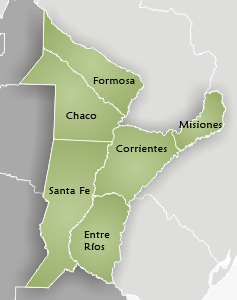martes, 30 de septiembre de 2008
THE LEGEND OF THE CEIBO FLOWER / LALEYENDA DE LA FLOR DEL CEIBO
a long time ago, when the Spanish conquerous arrived in these lands, they came across a brave native tribe that offered strong resistance.
The cacique had a daughter called Anahì `s father was killed by a Spanish soldiers.
She decided to guide her people in the fight.
She went to the pleace where the Spanish had their camp and killed her father `s murderes.
The Spanish conquerours condemned her to be burnt alive slowly.While she suffered the torture tied to a tree,she sang the sweettest of all songs a farewall message to her peolple and land.
The next morning they found out bright scarlet flowers around the tree.
The believed these flowers had come from Anahì`s blood,and they were a gift for her people.
--------------------------------------------------------
En noviembre 22 en Argentina y Uruguay todos celebramos el dìa internacional de la flor del Ceibo.
Hace mucho tiempo,cuando los conquistadores españoles llegaron a esas tierras,se encontraron con una tribu nativa.Era fuerte y resistente.El cacique tenìa una hija llamada Anahì.Durante una batalla el papà de Anahì mato a un soldado español.
Ella decidiòguiar a las personas durante las peleas.
Ella fue al lugar donde los españoles tenìan un campeonato y mataron a su padre.
Los conquistadores españoles la condenaron a ser quemada viva lentamente.Mientras sufrìa la tortura atada a un àrbol,ella canto la canciòn màs dulce como mensaje para su gente y tierra.
A la siguiente mañana encontraron flores escarlatas alrededor del àrbol.
Todos crayeron que estas flores se habìan creado con la sangre de Anahì y era para toda su gente.
martes, 23 de septiembre de 2008
National festival of "THE DORADO" / Fiesta nacional de "EL DORADO"
- Falk parties.
- Sport competition.
- Criollos bonfires.exhibitions.
- Cultural meetings.
- The lection of the queen of the Dorado.
- Roast meat.this is usually ox meat and is seved in the Brazilian style as "chop on a sword".
- Fish as dorado ,surubi,paci and sàbalo are grilles or baked.
- Locro norteño (made with meat,maize,pimkin and cassava)
- "mbeyù" (fried cake with tapioca)
- "chipà".
- Paraguayan soup.
History: the Gualeguaychu carnival in Entre Rios is the most important open air event of the country.It started at the end of the XIX century.In 1930,the goverment built an enormous catwalk. It was on this catwalk where the orchestras and the "murgas" (band of street musicians and dancers)acted.In the following decades,in the 30s and 40s, the traditional "murgas" appeared,they sang their songs and danced their own choreagraphies. Big groups from different parts of the city participated. In this way the carnival became famous in the whole country.
More Information: the Gualeguaychu Carnival takes place in the "corsodromo", where the chariots parade is the most important event since 1959 there is also digital sound and food service for the espectators.
-----------------------------------------
El Dorado es una de las especies de pez mas tradicionales de la Argentina y el mas conocido en todo el mundo.
Actividades: pescadores van a Corrientes, sobre la costa de los rìos Paranà y Corrientes con el sueño de pescar el Dorado mas grande. Desde el 15 hasta el 18 de agosto en paseo de la patria le dan la bienvenida miles de pescadores anciosos por vivir esta fascinante aventura en los Esteros, Ibera, Bella vista, Esquina, Empedrado, Ità Ibatè y Goya.
- Competencias deportivas.
- Fiestas folclòricas.
- Fogones criollos.
- Exposiciones.
- Actos culturales.
- Eleccion de la reina.
Platos tipicos:
- Carne asada. Procede del cebrí y se sirve al estilo Brazilero como "churrasco al espadachín".
- Pescados como el Dorado, Surubí y Sábalo horneado o grillado.
- Locro Norteño (preparado con carne, maíz, calabaza y mandioca).
- "mbeyú"(torta frita con tapioca).
- Chipá.
- Sopa Paraguaya.
Historia: el carnaval the Gualeguaychu, en la provincia de Entre Ríos, es el evento a cielo abierto más importante del País. Comenzó a fines del siglo XIX, alrededor de 1930, se construía en el medio una enorme pasarela, en la que actuaban las orquestas, murgas y conjuntos. En las decadas siguientes, años 30 y 40, se impusieron las murgas tradicionales, estas cantaban sus canciones y bailaban sus propias coreografías.Venían numerosas agrupasiones desde todos los barrios. Esto llevó poco a poco nuestros corzos al rangode los más deslumbrantes del País.
Más Información: el carnaval de Gualeguaychú se reliza en el "Corsodromo" donde, desde 1959 se celebra un delfile de carrozas. Este escenario al aire libre con capacidad para 35.000 personas, cuenta con sonido digital y servicios gastronómicos.
martes, 16 de septiembre de 2008
Caracteristicas de la Regiòn
Ríos de grandes caudales y arroyos que se desprenden como finos hilos de agua enriquecen el suelo de este rincón argentino de gran belleza y esplendor. La mayor parte de su extensión es baja, donde se forman pantanos, grandes albergues de flora y fauna autóctonas en los que cada día la naturaleza revive con mayor fuerza.
Hacia el sur, esteros y sierras bajas colaboran para variar la totalidad del cuadro y proponer otro tipo de turismo.
Y hacia el norte, las elevaciones rocosas forman inmensos e indescriptibles saltos de agua que caen violentos sobre el cause de los ríos que se pierden en el paisaje selvático.


